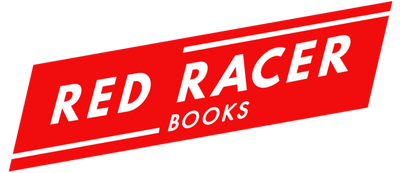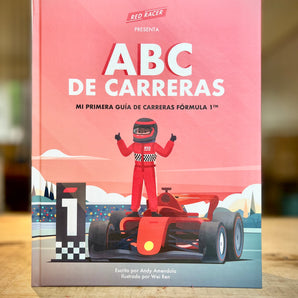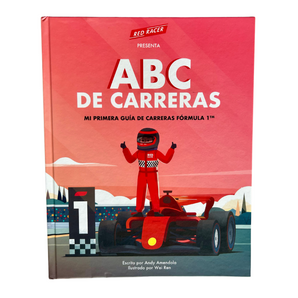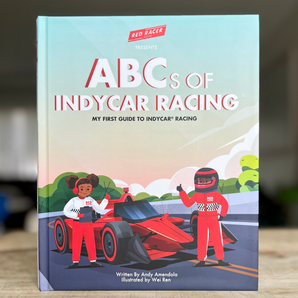Explore our fun and easy-to-understand racing glossary for kids!
I’ve simplified racing terminology and phrases you might hear during a race weekend to create this list of F1 words in alphabetical order. It’s perfect for young fans (and the young at heart!) to learn the most common Formula 1 terms—many of which come straight from the pages of our racing books.
From race cars to racing heroes, our collection of children’s picture books is crafted to engage, empower, and inspire a new generation of motorsport fans. Dive into this exciting guide that’s great for young racing enthusiasts, future engineers, world champions, and their families who want to learn the basics of motorsports.
Think of it Like a Dictionary of Racing for F1 Kids
P.S. If you like this you will love our books.
-Andy Amendola
The Unofficial Dictionary of F1 for Kids!
Aérodynamique
The study of how air moves around things is aerodynamics – F1 cars are designed so that air flows in a way that helps them go as fast as possible.

Where it all began, first letter of our first book, ABCs of Racing.
Aerorake
This is a big comb-like device attached to the car that helps engineers understand how air flows over the car. It's crucial for improving aerodynamics, which helps cars stick to the ground and grip corners better.
Autodromo di Monza, or simply Monza
Monza is a world-famous circuit, known as the "Temple of Speed" because it’s the fastest track of all. Since 1950, it has hosted every Italian Grand Prix, except for one year when it was held at Imola. In Italy, they call it the "Pista Magica" and it’s the home track of the Scuderia Ferrari team.
From our Italian Children's F1 Kids Book, L’ABC delle Corse La mia Prima Guida alle gare di Formula Uno
Box
When cars need to change tires (“tyres” in F1 speak), they come in for a pit stop. Box is the nickname for pit stop. During a race, you may hear “box box” over the car radio when the team says it’s time for a pit stop.
Brakes
Brakes are a crucial part of a race car, and drivers need to learn to brake as late as possible. Did you know that the brakes on an F1 car can reach 1000°C (1832°F) without a problem? How cool is that!

From All about Race Cars.
Circuit

A racing circuit is the playground for race car drivers! These specially designed tracks can be found all around the world. They feature a variety of turns and straights, giving drivers the ultimate challenge of speed and skill.
From our French Book, this illustration is inspired by the distinct Circuit Paul Ricard, former home of the French Grand Prix 🇫🇷 ABCs of Racing in French - l'ABC de la Course - Mon Premier Guide de la Formule 1
Champion
At the end of the season, the driver with the most points wins and claims the very cool title of World Champion.
DRS
Drag Reduction System – During a race, drivers can use DRS to get extra speed by adjusting their rear wings temporarily. It’s like getting a turbo boost!
Engine
That’s what makes the cars move. Today, F1 cars have hybrid engines. They are part internal combustion and part electric. How neat is that?
Learn more about F1 Engines in All about Race Cars available on amazon.
Engineering
Engineering uses science and math to design, build, and operate machines. In racing, engineering is essential because F1 cars are incredibly complex. Many engineers work on the cars every day, listening to driver feedback and collecting data to constantly improve race performance.

Illustration from our Italian language F1 Kids book, L’ABC delle Corse La mia Prima Guida alle gare di Formula Uno. Also on Amazon.
FIA
Fédération Internationale de l'Automobile – or the International Federation of Automobiles in English. The FIA is the organization that manages racing and ensures fairness and safety of all motorsports.
Flags
To communicate with drivers, race officials wave flags of different colors and styles, each with its own meaning. The checkered flag, which signals the end of the race, is my favorite!
Flag Image from ABC French Book

Flow Vis Paint
Flow Vis Paint is a special paint that F1 teams use on their cars to see how the air moves around the car, The paint is added to the car in certain spots before hitting the track during testing or practice sessions. As the driver races around, the paint moves, revealing where and how the air flows! It's like a big science experiment on wheels! Where is it smooth? Where is it not so smooth? This is helpful real-world testing on top of the engineers’ work done in wind tunnels
Formation Lap
This is one last practice lap to warm up before the drivers line up in their starting order and then begin the race.
G’s
These are a measure of gravitational force or force that results from acceleration.
Grand Prix
The name of the official F1 races is Grand Prix (Sounds like “Pree”). Each year there are around 22 of these races all over the planet.
Halo
A horseshoe-shaped protective bar on top of the car keeps the driver safe. It’s a fairly new invention, introduced in 2018, and it has protected many drivers during accidents. Que Bueno! That’s good!
HP
Stands for horsepower which is how we measure the power an engine has. The more horsepower, the larger amount of power an engine has.
ICE
Internal Combustion Engine – cars that run on fuel (gasoline or diesel) have this type of engine. As opposed to some newer cars that have electric engines.
International
Formula 1 racing is a global sport with races on five continents and drivers who speak many different languages.
Jumpstart
When a driver moves forward before the race officially starts, they will get a penalty for a jumpstart. Naughty, naughty!
Karting
Kart racing is a competition of go-karts and is where many of the world champions started, some karting as early as age three! Can you believe that?
KPH
Kilometers per hour – Most countries around the world use the metric system for all measurements, and they measure speed with kilometers. Race coverage typically covers both, but KPH is more prominent than MPH.
Lap
One turn around the track course from start to finish is a lap. F1 races have about 50-70 laps depending on the circuit, and each Grand Prix typically lasts two hours.
Lap Time
In racing, every second counts. A lap time is the time it takes for a car to go around the track from start to finish. Drivers try to set the fastest time during qualifying, but during the race, they might go a little slower to make their tires last longer.
Monaco
The location for the most famous and glamorous race of all motorsports is Monaco. The circuit is surrounded by yachts. Very cool!
MPH
Miles per hour – it’s how speed is measured in the USA.
Nose Cone
This is the pointy part at the front of the car that helps it break through the air. Planes, rockets, and submarines also have nose cones.
Overcut / Undercut
Among race strategies, there's the overcut, which involves staying on the track for a few extra laps before pitting to gain time over a direct competitor. It's the opposite of the undercut.
Oversteer / Understeer
When the rear of the car slides out more than the driver intends, it's called oversteer. The opposite happens with the front in the case of understeer. Both situations are common as drivers push their cars to the limit during a race.
Overtake
When one car gets past another during a race, they overtake them. This is when it gets really exciting, and sometimes cars get too close and bump each other off the track.
Pitstop
When Formula 1 cars need to change tires, they come in for a pitstop in the designated pitbox. During the race, you might hear "box box" on the team radio, signaling that it's time for the car to make a pitstop.

Illustration inspired by the Red Bull Racing Team that is known for incredibly fast pitstops! From our Dutch F1 Kids book ABC Voor Racers.
Podium
This is the raised stage where the drivers in 1st, 2nd, and 3rd places get their trophies and spray champagne. It’s a celebration!

P is for Podium, from our first book ABCs of Racing: My First Guide to F1 Racing . Also available on AMAZON.
Qualifying
When the teams compete to determine the starting order for the race, they are qualifying. Whoever gets the fastest time is in pole position and starts first in the order. The rest are ordered based on their fastest lap times.
Race Weekend
F1 races are three-day events with Practice, Qualifying, and the main event, Grand Prix, which always falls on a Sunday.
Racing Line
The fastest and most efficient way to go around a track. Sometimes, when a driver attacks another car, they have to move off the racing line, but this can be risky.
Results
When the race is over, drivers earn points toward the world championship standings. The top three finishers—1st, 2nd, and 3rd place—receive trophies during the podium ceremony. Traditionally, they celebrate by spraying champagne!
Safety Car
An official car comes out when something dangerous happens on the track, like an accident or bad weather. The safety car goes in front of all the other cars and slows them down until the race is ready to continue.
Sandbagging
Teams may deliberately drive slower during testing to hide their true speed from competitors until the first race of the season. It's a sneaky tactic to keep their potential hidden.
Starting Lights / Sequence
The lights are all initially off and then turn on one by one, until all five are on red. When all the lights then turn off simultaneously, the race begins... START!"
Starting Order
Before the race begins, the cars must line up in the correct starting order. They line up in pairs, like crossword puzzle squares, with each row spaced 8 meters apart. The two fastest drivers in qualifying start in the front row, and the driver starting in first position is said to be in “pole position.”
Steering Wheel

Formula 1 race cars are highly advanced machines with complex controls, more like an airplane than a regular car. This is clear from their steering wheels, which have around 25 different buttons and knobs. Drivers always know exactly what to press while driving at high speeds—amazing!
STEM
Formula One racing is all about innovation in STEM. That stands for Science, Technology, Engineering, and Math. All are important components for understanding, building, and running race cars!
Explore STEM further in All About Race Cars - A Guide to Formula 1 Race Cars Hardcover Picture Book for Kids 5-10
Team
In F1 racing, there are 10 teams, or "Scuderia" in Italian (or "Escudería" in Spanish!). Teamwork is everything in racing, and Formula 1 has the largest teams of people working together. Each team has two drivers, but they also rely on many others—engineers, mechanics, analysts, scientists, strategists, directors, and support staff.

Illustration from our Spanish F1 Kids Book ABC de Carreras: Mi Primer Guía de Carreras Fórmula 1 en Español! Encuentralo en Amazon.
Technical Regulations
The word "Formula" refers to the technical regulations that each team must follow for their F1 car. There are very specific rules that dictate how a car and its parts can be configured.
Tifosi
The passionate racing fans who enthusiastically support Italian drivers and the Ferrari teams are known as Tifosi. They often wear red and can be seen all around the world cheering for their teams! Are you a Tifoso?
Tyres in the UK, Tires in the USA

Since F1 racing began in England, tyres are spelled with a "y" in the UK, while in the USA they’re spelled tires. No matter how you spell it, they are the most important part of the car, as they’re the only point of contact with the track. For each race, teams choose between hard, medium, or soft tyres, and they must switch them at least once during the race. And when it rains, they have two more options: intermediates for light rain and full wets for heavy rain.
Tires Section from ALL ABOUT RACE CARS
Understeer
When the car turns less than the driver wants, it’s called understeer. The opposite happens in oversteer. Both are common as drivers push their cars to the limit during a race.
V6, V8, V10
The V refers to the shape of the 2-cylinder banks of ICE engines, and the numbers refer to how many cylinders the engines have. For example, a V6 has a V-shaped engine with 3 cylinders on each side. Today's F1 Race Cars have a hybrid V6.
Visor
This is an important part of the helmet that allows the drivers to see while protecting their eyes as they drive at speeds of 200 mph or more.
Wind Tunnel
Teams use a wind tunnel when developing their cars. A wind tunnel simulates airflow and allows engineers to adjust the car’s wings to improve speed.

Illustration from our Spanish F1 Kids Book ABC de Carreras: Mi Primer Guía de Carreras Fórmula 1 en Español! Encuentralo en Amazon.
Wings
Like planes, F1 cars have wings too. But instead of using them to get off the ground, F1 car wings in the front and back push the car down closer to the ground, allowing it to grip the track and go faster.
Dive into aerodynamics of an F1 Race Car with All about Race Cars Hardcover kids book great for kids 5-10

Yellow Flag
This flag gets waved when there is something dangerous on the track. It lets drivers know that it’s time to slow down.
Zandvoort
This beach town is the home of the Dutch Grand Prix. It's one of the oldest circuits in the world, with the first Formula 1 race in Zandvoort taking place in 1952. In 2021, Max Verstappen became the first Dutch driver to win the race at Zandvoort.
Image of our F1 Kids Book in Dutch - 🇳🇱 ABC Voor Racers - Mijn Eerste Handboek Voor De Formule 1 - Also available on Amazon.
Zylon
A super strong material used in drivers’ helmets and cockpits to increase their protection is called Zylon®.
Ready to learn more about racing?
We hope you enjoyed our A to Z Formula One Racing Glossary for F1 Kids! Whether you're just getting started or you’re already a motorsport enthusiast, there's always more to discover about the world of racing. Be sure to check out our collection of exciting books at Red Racer Books, where kids (and grown-ups) can dive even deeper into the thrills of motorsports. Keep following our blog and social media for more fun racing facts, stories, and events!
P.S. If you loved this glossary, don’t forget to share it with other young racing fans. Let's inspire the next generation of Formula 1 heroes together! And if you do make sure to tag us @RedRacerBooks on Twitter/X, Instagram, Facebook and TikTok.











